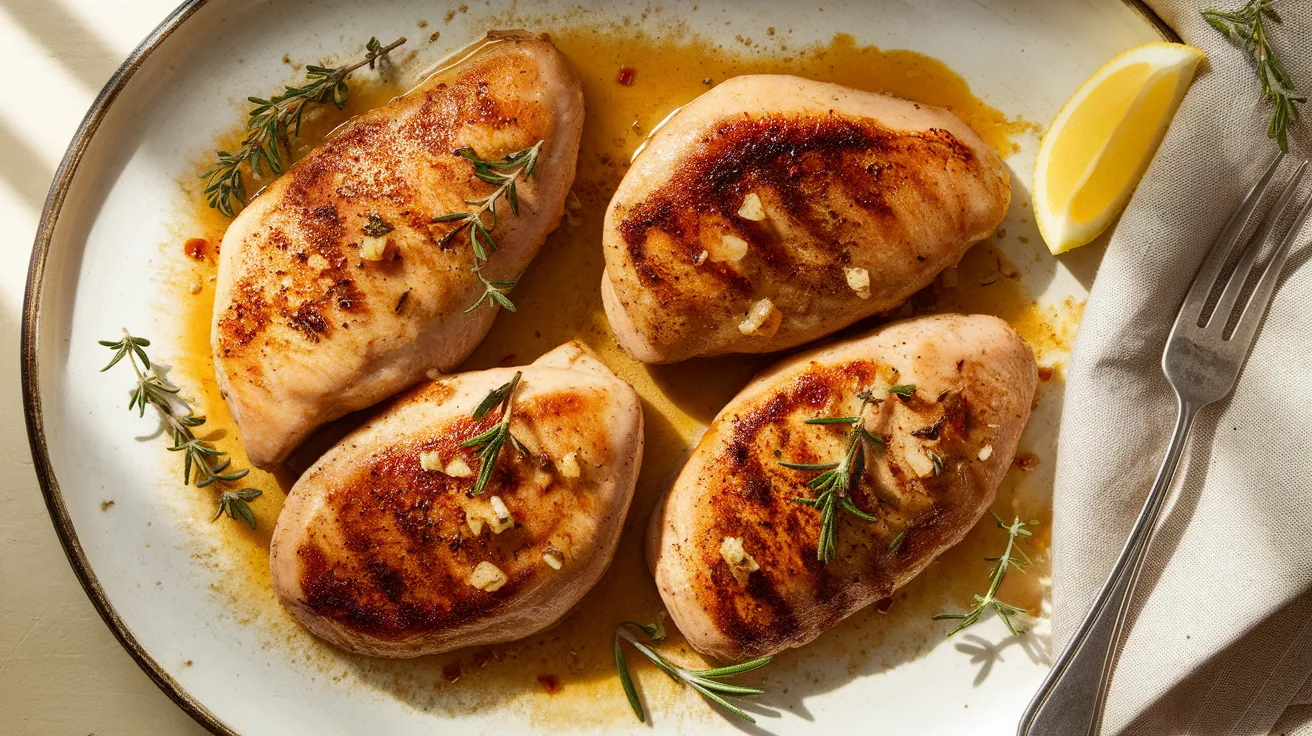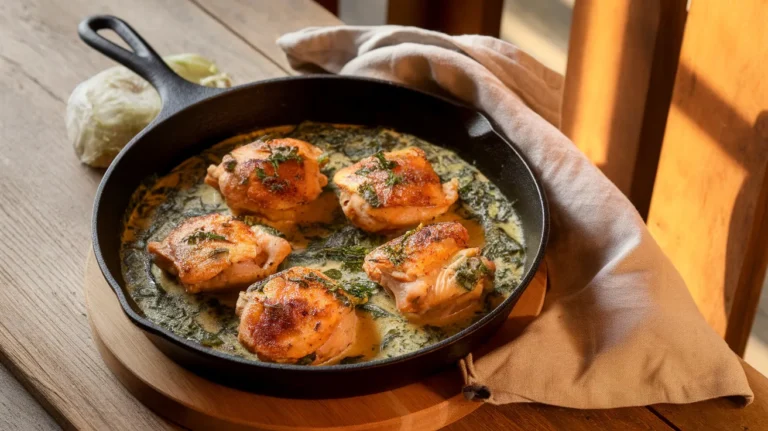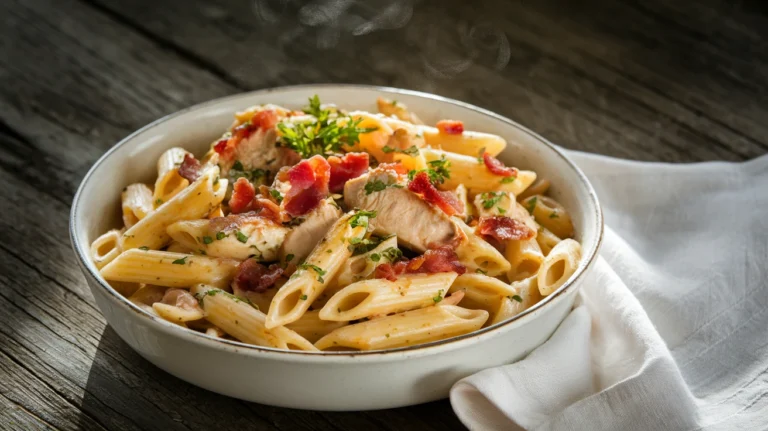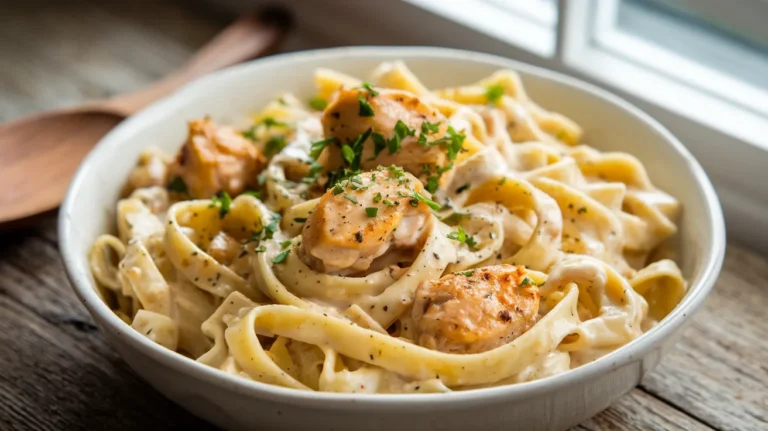This savory chicken recipe transforms ordinary chicken breasts into a restaurant-quality dinner that’s ridiculously easy to make. With a perfect blend of herbs, garlic, and butter, this savory chicken delivers juicy, flavorful results every single time—and it’s ready in under 40 minutes.
SERVES: 4 | PREP: 15 MIN | COOK: 25 MIN | TOTAL: 40 MIN
What Makes This Savory Chicken So Good
I’ve made this recipe probably 200 times, and it never gets old.
The secret? A simple herb butter that seeps into every bite while the chicken stays incredibly moist.
You don’t need fancy ingredients or complicated techniques—just good chicken and a few pantry staples that create magic together.
Ingredients You’ll Need
For the Chicken
| Ingredient | Amount |
|---|---|
| Boneless, skinless chicken breasts | 4 pieces (6-8 oz each) |
| Olive oil | 2 tablespoons |
| Salt | 1½ teaspoons |
| Black pepper | ¾ teaspoon |
| Garlic powder | 1 teaspoon |
For the Savory Herb Butter
| Ingredient | Amount |
|---|---|
| Unsalted butter | 4 tablespoons |
| Fresh garlic, minced | 4 cloves |
| Fresh thyme | 2 teaspoons (or 1 tsp dried) |
| Fresh rosemary, chopped | 1 teaspoon (or ½ tsp dried) |
| Fresh parsley, chopped | 2 tablespoons |
| Lemon juice | 2 tablespoons |
| Paprika | ½ teaspoon |
Step-by-Step Instructions
Phase 1: Prep the Chicken (5 minutes)
Step 1: Take your chicken breasts out of the fridge and let them sit on the counter for 10-15 minutes.
This brings them closer to room temperature, which means they’ll cook more evenly and won’t be raw in the middle while overdone on the outside.
Step 2: Pat each chicken breast completely dry with paper towels.
This is crucial—wet chicken won’t brown properly, and you’ll miss out on that delicious golden crust.
Step 3: If your chicken breasts are thick (more than 1 inch), place them between two pieces of plastic wrap and gently pound them with a meat mallet or rolling pin until they’re about ¾ inch thick throughout.
Even thickness means even cooking, so no more dry edges and raw centers.
Step 4: Season both sides of each chicken breast generously with salt, black pepper, and garlic powder.
Don’t be shy here—chicken needs bold seasoning to taste amazing.
Phase 2: Sear the Chicken (8 minutes)
Step 5: Heat a large skillet (12-inch works best) over medium-high heat for 2 minutes until it’s properly hot.
You want the pan hot enough that when you add the chicken, it sizzles immediately—this creates that beautiful golden crust.
Step 6: Add 2 tablespoons olive oil to the hot pan and swirl it around to coat the bottom.
Wait 30 seconds until the oil shimmers and moves easily across the pan.
Step 7: Carefully place all 4 chicken breasts in the pan, making sure they’re not touching each other.
If they overlap, they’ll steam instead of sear, and you won’t get that gorgeous brown exterior.
Step 8: Let the chicken cook without moving it for exactly 5 minutes.
I know it’s tempting to peek, but resist! Moving it too early will tear the crust and leave you with sad, pale chicken.
Step 9: Flip each piece of chicken using tongs (not a fork—you don’t want to pierce the meat and lose juices).
The bottom should be golden brown with some darker caramelized spots.
Step 10: Cook the second side for 3 minutes.
The chicken won’t be fully cooked yet, but that’s okay—we’re finishing it in the next phase.
Phase 3: Create the Savory Herb Butter (2 minutes)
Step 11: Reduce the heat to medium-low (this prevents the butter from burning).
Add 4 tablespoons butter directly to the pan around the chicken pieces.
Step 12: As soon as the butter melts (about 30 seconds), add the minced garlic, thyme, rosemary, and paprika to the butter.
Stir the herbs and garlic into the butter using a spoon, letting that incredible aroma fill your kitchen for about 1 minute until the garlic softens and becomes fragrant.
Phase 4: Finish Cooking (10 minutes)
Step 13: Tilt your pan slightly and use a spoon to scoop up the herb butter, then pour it over the top of each chicken breast repeatedly for about 1 minute.
This technique (called basting) infuses the chicken with all those savory flavors while keeping it incredibly moist.
Step 14: Cover the pan with a lid and let the chicken finish cooking for 8-10 minutes.
The internal temperature should reach 165°F when you insert an instant-read thermometer into the thickest part of the breast.
Step 15: Remove the pan from heat and stir in the lemon juice and fresh parsley to the butter sauce.
The lemon brightens everything and cuts through the richness perfectly.
Step 16: Let the savory chicken rest in the pan for 5 minutes before serving.
This allows the juices to redistribute throughout the meat instead of running all over your cutting board.
Step 17: Serve each chicken breast with a generous spoonful of that incredible herb butter from the pan.
Chef’s Notes
Butter Timing: Adding butter after the initial sear prevents it from burning during high-heat cooking while still delivering maximum flavor.
Herb Flexibility: Can’t find fresh herbs? Use half the amount of dried herbs—they’re more concentrated, so you need less to achieve that savory chicken flavor.
Resting Matters: Those 5 minutes of resting time aren’t optional. Cut into the chicken too early, and all the juices run out, leaving you with dry meat.
Pan Selection: A stainless steel or cast iron skillet works better than nonstick for this recipe because it creates better browning and develops those flavorful browned bits.
Nutrition Facts (Per Serving)
Calories: 340
Protein: 42g
Carbohydrates: 3g
Fat: 18g
Fiber: 0g
Sodium: 780mg
Delicious Variations
Mediterranean Savory Chicken
Replace the thyme and rosemary with oregano and add ½ cup chopped sun-dried tomatoes and ¼ cup sliced Kalamata olives during the last 2 minutes of cooking. The tangy, briny flavors pair beautifully with chicken.
Spicy Cajun Style
Mix 1 tablespoon Cajun seasoning into your initial chicken seasoning and add ½ teaspoon cayenne pepper to the herb butter for a kick. If you love bold flavors, try this alongside our red pepper chicken for a spicy dinner lineup.
Asian-Inspired Savory Chicken
Replace the herbs with 1 tablespoon grated fresh ginger, 2 tablespoons soy sauce, and 1 teaspoon sesame oil in the butter mixture. Garnish with sliced green onions and sesame seeds. For more Asian-style chicken inspiration, check out our Chinese chicken on a stick.
Creamy Mushroom Savory Chicken
After removing the cooked chicken from the pan, sauté 8 oz sliced mushrooms in the herb butter for 3 minutes, then add ½ cup heavy cream and let it simmer for 2 minutes. Pour this sauce over the chicken before serving.
Storage & Reheating
Refrigerator: Store cooled savory chicken in an airtight container with any remaining herb butter for up to 4 days.
The butter will solidify when cold, but it melts beautifully when you reheat.
Freezer: Wrap each chicken breast individually in plastic wrap, then place in a freezer bag for up to 3 months.
Thaw overnight in the refrigerator before reheating.
Reheating: The microwave works but can dry out the chicken. Instead, reheat in a covered skillet over medium-low heat with a splash of chicken broth or water for 5-7 minutes until warmed through.
The oven works great too—reheat covered at 350°F for 12-15 minutes.
Pro Tip: Slice leftover savory chicken and use it cold in salads or sandwiches the next day. It’s incredibly flavorful even at room temperature.
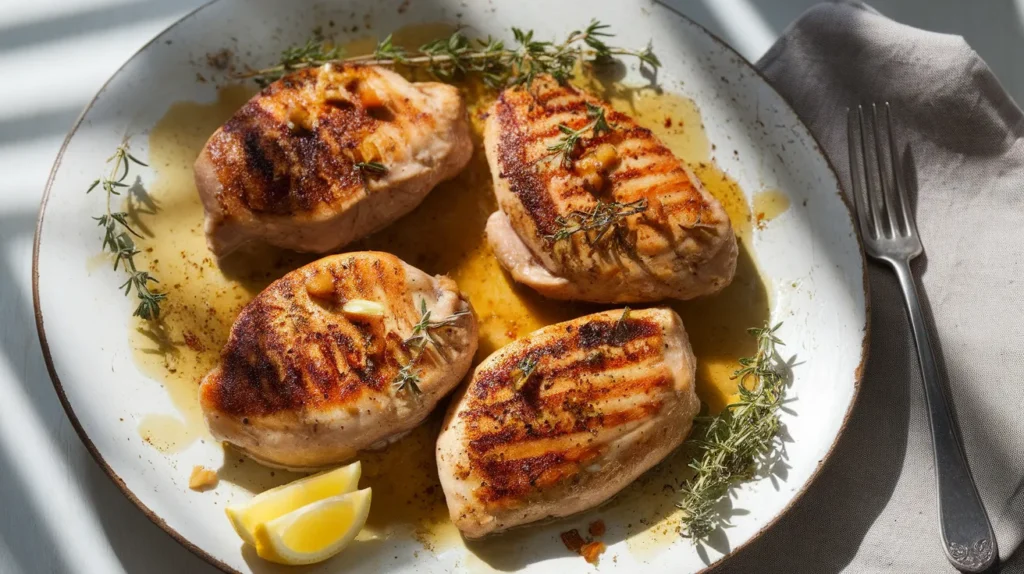
Troubleshooting Common Problems
Problem 1: Chicken Is Dry and Overcooked
Solution: You likely cooked it past 165°F. Invest in an instant-read thermometer (they’re $15 and game-changing). Start checking the temperature at the 15-minute mark of total cooking time. Remember, the chicken continues cooking for a few minutes after you remove it from heat, so pulling it at 160°F is actually perfect.
Problem 2: Chicken Is Raw in the Middle
Solution: Your chicken breasts were probably too thick or uneven. Always pound them to uniform thickness before cooking. If you discover raw chicken after slicing, simply return the pieces to the pan, cover, and cook for another 3-5 minutes on medium-low heat.
Problem 3: Butter Sauce Looks Separated or Greasy
Solution: Your heat was too high when you added the butter. If this happens, remove the pan from heat and whisk in 1 tablespoon cold butter or 1 tablespoon cream to bring it back together. The emulsification will smooth everything out.
Problem 4: Garlic Burned and Tastes Bitter
Solution: You added the garlic to butter that was too hot. Next time, make sure to reduce heat to medium-low before adding butter and aromatics. If the garlic burns, unfortunately you need to wipe out the pan and start the butter sauce fresh—burned garlic ruins the whole dish.
Problem 5: Chicken Stuck to the Pan
Solution: You either moved it too early or your pan wasn’t hot enough to start. Let the chicken sear undisturbed for the full 5 minutes—it will naturally release when it’s ready. Using enough oil (don’t skimp on those 2 tablespoons) also helps prevent sticking.
Equipment Essentials
- Large 12-inch skillet (stainless steel or cast iron preferred)
- Instant-read thermometer
- Meat mallet or rolling pin (for pounding chicken)
- Tongs
- Measuring spoons
- Chef’s knife
- Cutting board
- Mixing spoon or spatula
- Paper towels
- Lid for your skillet
Shopping List
Meat Department
- 4 boneless, skinless chicken breasts (6-8 oz each)
Produce Section
- 1 bulb fresh garlic
- Fresh thyme (small package)
- Fresh rosemary (small package)
- Fresh parsley (1 bunch)
- 1 lemon
Dairy Section
- Unsalted butter (1 stick)
Pantry/Spices Aisle
- Olive oil
- Salt
- Black pepper
- Garlic powder
- Paprika
Success Secrets
1. Temperature is Everything
An instant-read thermometer removes all guesswork. Chicken is safe at 165°F, but it’s most juicy between 160-165°F since carryover cooking adds a few degrees.
2. Don’t Crowd the Pan
If your chicken pieces are touching or overlapping, they’ll steam instead of sear. Use a larger pan or cook in batches if needed.
3. Save That Butter Sauce
The herb butter left in the pan is liquid gold. Spoon it over rice, pasta, or roasted vegetables to extend that savory chicken flavor to your entire meal.
4. Pound for Perfection
Taking 2 minutes to pound your chicken to even thickness is the difference between mediocre and restaurant-quality results. Uneven chicken means uneven cooking—always.
5. Let It Rest
Patience during the 5-minute rest period pays off with juicier, more flavorful chicken. Use this time to set the table or prepare your side dishes.
This savory chicken recipe proves you don’t need complicated techniques or expensive ingredients to create something truly delicious. Master this one, and you’ll have it in your regular rotation forever.
